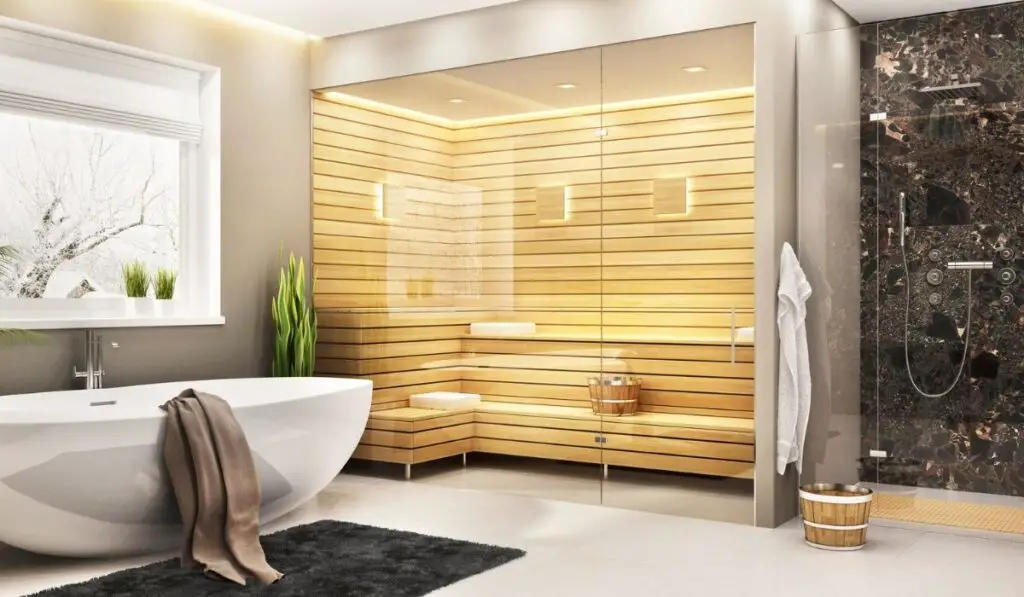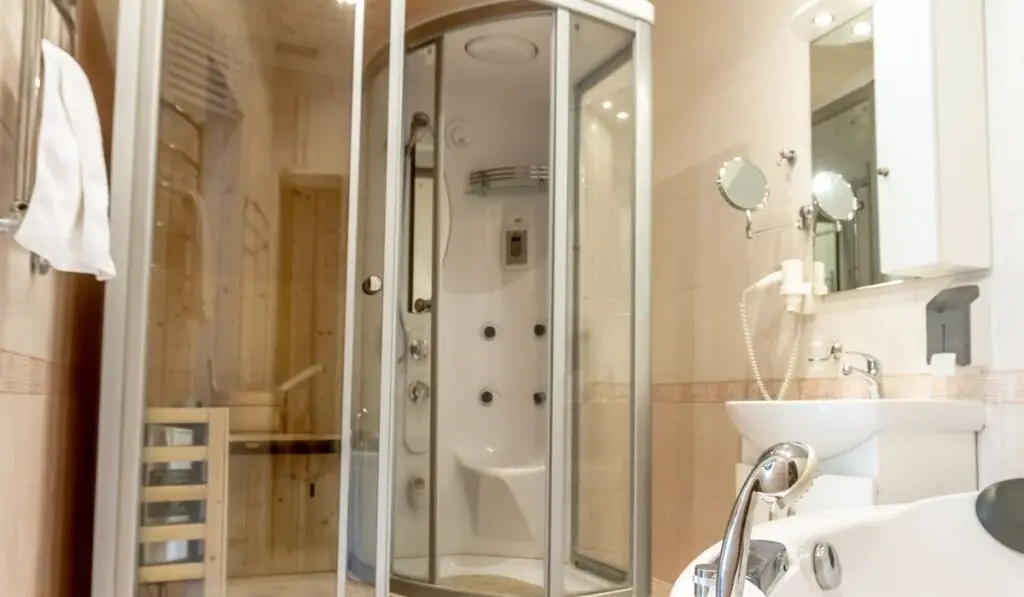Many people would love to have a sauna in their homes. Just imagine being able to use a sauna at your leisure anytime you wished. If you’ve made up your mind and are ready to purchase a sauna kit for your home, you’re almost past the first step. The next step is getting it installed. You might have some ideas on where to put it in your home already, or perhaps you haven’t given it too much thought yet. In either case, there are a few critical things you should be aware of before picking a permanent installation spot.
A sauna can be placed in virtually any room of your home. However, you should take into account power location, venting, and accessibility, plus proximity to a shower. Additionally, you’ll need a minimum floor space of 6×6 feet to fit the sauna.
Most sauna installations are permanent, meaning they cannot be moved from one location in your home to another. Therefore, you should make a fully informed and educated decision about where to install your sauna instead of making an off-the-cuff selection. To discover the importance of home sauna location, ideas on where to put it, and how much they cost, continue reading this detailed guide.
How Important is Sauna Location in Your Home?

The location of the sauna in your home is crucial and it is definitely a decision you should not take lightly. You’re planning on having a sauna installed to use frequently, and for that reason, the location should be paramount. Additionally, the location of the sauna in your home could affect its value as we’ve argued elsewhere on the site before.
Ideally, you would have your sauna installed in a spare room or unused space. In other words, if you have empty space in your home, that should be your first option for the installation location. Conversely, you wouldn’t want to install it in an area like an attic, where you’d have to run power or install insulation.
Where to Put Your Home Sauna
As we previously discussed, the location of the sauna in your home is essential. To make your placement decision even more complicated, there are many facets of the location you need to consider. Most saunas can be placed in more than one location in a house. Here are some of the things to think about when installing a sauna in your home.
Which Sauna Location Is Ideal?
The ideal location for a sauna depends on the layout of your home and your personal preference. You’ll want to make sure you feel comfortable and have enough space. For example, you can snuggle a small-sized sauna into your master bathroom, or if you’re an empty nester, you can put it in one of your children’s former bedrooms.
Since saunas make you sweat profusely, most homeowners prefer to have a shower located nearby. Therefore, close to a bathroom is usually the most ideal location. Alternatively, you can install the sauna and an additional shower there if you have extra space in your basement. However, you’ll need a water connection nearby.
Some sauna owners have thought outside the box, and instead of putting a sauna in your home, they install it in a heated garage, pole barn, or other types of outbuildings. Lastly, many sauna aficionados prefer to take breaks outdoors in between sauna sessions, especially in the winter months. Therefore, if you have this preference, an ideal sauna location for you may be near an exterior door.
The Ideal Size of a Sauna
The perfect size of a sauna boils down to how you want to use it, how much free floor space you have, and your physical size. If you only want to sit down in the sauna, you’ll only need a relatively small area – at the minimum of 6 by 6 feet. However, if you want to lie down in the sauna or you want to have 2-4 guests join you, you will obviously want a larger sauna to accommodate more people.
A big sauna takes up a lot of floor space, too, so you will need to have ample room for one. In this case, an area in an unfinished basement is perfect. Otherwise, you can get an outdoor sauna if you don’t have the indoor floor space available. Some larger saunas are bigger than 12 x 12 feet or the size of a bedroom!
On What Floor Should Saunas be Located?
Most saunas have a floor included, so this may not matter too much. However, some saunas do not include a floor and use the existing floor where you’re installing it. Therefore, you wouldn’t want to install it on a carpeted area unless you are okay with removing the carpet entirely or building a platform for the sauna to sit on.
Floor with hard surfaces are best suited for saunas, really any material besides. Wood, ceramic, plastic, and concrete, all work very well. But it is best to make sure the floor is thermally insulated. Otherwise, you can use a wooden or PVC floor grate that can be put on top of the floor to serve as a barrier.
What’s the Best Sauna Floor Plan?
This might be starting to be repetitive, but the best sauna layout is subjective. So, it varies depending on the person. However, most common configurations have the heater near the door and the benches near the back.
If the sauna is deep enough, multiple levels of benches can be included. The second bench level serves two purposes. The first purpose of the second level is for more seating, so more people can join you. The second is to give you an option of a slightly warmer location. As most people know, heat rises, and if you are sitting higher up in a sauna, you will be experiencing a higher temperature.
There are various configurations of saunas you can choose from, and depending on your space requirement, a square one may fit your space the best or perhaps a rectangular shape would be better. Lastly, while the heater located near the door is very common, another popular configuration is a setup with a rear-wall heater.
Electrical Connections Considerations
When you’re installing a sauna in your home, you’ll also want to consider access to power or electricity. Some tiny home sauna kits just plug into a standard outlet, but ones with larger furnaces above 9 kW require an independent circuit breaker with 400 volts. Therefore if the space you want to install a sauna in your home does not have power access, you’ll have to pay extra to have an electrician set this up.
Usually, a sauna installer leaves wiring up to a certified electrician to ensure it meets code and safety standards. For the lighting in your sauna, most often, a 230/240-volt connection is required. The wiring and connections for the lighting can be completed at the same time as the sauna heater.
Additionally, if you want speakers or smart home controllers installed in your sauna, an excellent time to have that done would be when the electrician is already working on wiring the power. Finally, an extra circuit breaker will likely need to be added to your breaker box, depending on the sauna’s power requirements.
Proximity to a Shower

If you’re using a sauna the right way, you should be sweating a lot and after your sessions, you’ll likely want to shower right away. Showering right after the sauna is the best thing you can do. It lowers your body temperature and allows blood to flow back from your extremities to your internal organs.
Showering also removes all the excess oils, salt, and germs from your skin that you sweat out. The act of sweating a lot, coupled with the high temperatures and showering directly after, reduces acne, swelling, and redness of your skin. In addition to all of these benefits, it also balances your skin’s pH levels.
Heater Options
There are various brands, types, and sizes of sauna heaters on the market. The power output measured in kW is crucial. Most sauna kit manufacturers and installers can provide size recommendations and the best sauna heater for you. You’ll want to make sure you get one large enough to heat your sauna. Here are some type of sauna heaters you can use:
- Electric heater
- Dry & hot version
- Mild & humid version or “bio sauna”
- Combi-heater that can switch between both
- Wood-burning heater
- Less common these days
Wood Interior Options
The wooden interior of saunas is not just for show. It serves as an insulation system too. Wood absorbs heat and releases it back into the sauna. And since the entire interior is made out of wood, it provides an excellent and steady warm temperature once it heats up. Some common wood used in saunas includes oak, fir, hemlock, aspen, and spruce.
All of these woods are of different colors and grain types. In addition, they all can withstand high temperatures without warping. When they are temperature treated, they become long-lasting, harder, and more resistant to damage from moisture.
Other Considerations
Additional considerations you should take when planning the installation of a sauna at home include many interior design decisions, room flow, and sauna setup. These are just a few examples of things you should consider. Additionally, you will want to think about the future value of your home, and if a future owner wants to remove it, will it be difficult? Here are some examples of things you should consider:
- Ventilation – if you choose to vent your sauna, will you vent it into your home or outside your home?
- Structural – if you want tall ceilings in your sauna, it will have to go into a tall room; additionally, you don’t want to block windows with the sauna
- Layout – the sauna shouldn’t be in an awkward spot; as an example, it a tight hallway where you can’t open the door all the way
- Insulation – you’ll want the ceiling insulation to converse heat and energy
- Door type – do you prefer a glass door sauna or a wooden one?
How Much Does a Home Sauna Cost?
On average, a home sauna installation costs anywhere between $3,000 to $10,000 for materials and $1,000 to $4,000 for labor and installation. Therefore you can expect to pay between $4,000 to $14,000 to add a sauna to your home. The prices vary by model, size, wood type, heater type, brand, and local labor rates.
Are There Less Intensive Home-Sauna Options?
There are less intensive options than a complete home-sauna solution. A new sauna is costly, and there are more cost-effective alternatives. For example, you can join a gym, a health club, or a sauna spa for sauna access; use a good friend’s or family member’s home sauna, use a portable sauna, or use an infrared sauna blanket (more on those in our guide).
Using a sauna at a health club, gym, spa, or at a friend’s house defeats the purpose of the convenience of a home sauna. However, there may be one nearby to your home that is convenient to visit. Alternatively, portable saunas like this one (on Amazon) and infrared sauna blankets like this one (on Amazon) can easily be used at home and are much less costly than a whole at-home sauna, ranging from $300 to $1,000.
